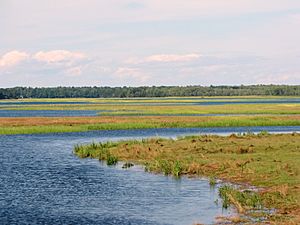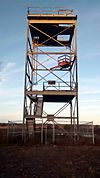Scarborough Marsh facts for kids
Scarborough Marsh is a huge 3,200-acre saltwater marsh in Maine. It's like a giant, watery playground for wildlife! The state of Maine owns it, and the Department of Inland Fisheries and Wildlife takes care of it as a special wildlife management area. You can find this amazing marsh in southern Maine, in the town of Scarborough, which is in Cumberland County. It's the biggest salt marsh in Maine!
Contents
What is Scarborough Marsh?
How Rivers Help the Marsh
The marsh gets its water from four rivers and many smaller creeks. Three of these rivers flow into the Scarborough River, which then empties into Saco Bay and the Gulf of Maine.
The main waterways flowing through the marsh are the Libby River, Nonesuch River, Dunstan River, Scarborough River, and several creeks like Jones Creek and Mill Brook. Many other tiny creeks also feed these main waterways.
Why Salt Marshes are Important
Salt marshes are super important! They act like natural filters, cleaning pollution from the water. They also provide food and safe homes for tons of different animals, including birds, fish, mammals, and shellfish. Because of all the amazing wildlife and different habitats it offers, the state of Maine considers Scarborough Marsh one of its most important coastal areas.
Protecting the Marsh
For a long time, people built homes and buildings on the higher lands around the marsh. The marsh itself stretches from Old Orchard Beach in the south almost to Cape Elizabeth in the north.
Luckily, now the state owns and protects the marsh. Also, groups like the Friends of Scarborough Marsh and the Scarborough Land Trust, along with the town of Scarborough, are working to make the marsh even bigger. They do this by buying or getting donations of private land that is inside or next to the marsh.
Part of U.S. Route 1, a major road, goes right through a section of the marsh.
Who Uses the Marsh?
The marsh is a busy place for people too! There are two farms that raise oysters here. Also, hundreds of people dig for clams, both for fun and to sell. Commercial lobstermen even dock their boats in one of the rivers. The town also offers a few spots where people can tie up their recreational boats.
Wildlife in Scarborough Marsh
Birds and Other Animals You Might See
Scarborough Marsh is a very important stop for birds traveling along the Atlantic Flyway. This means you can see lots of different kinds of waterfowl (birds that live near water) here. They stop to rest and eat on their way to Canada in the spring or heading south for winter in the fall. You might even spot seals or sometimes a porpoise in the Scarborough River, looking for food!
Helping the Marsh Heal
For a long time, people dug ditches in the marsh. They thought this would get rid of mosquitoes, but it actually made things worse! These ditches drained the marsh, lowering the natural water level and reducing the number of permanent pools where water usually stays. This also made the animals that eat mosquitoes disappear.
Since the early 2000s, a group called the Friends of Scarborough Marsh has been working hard to fix this. They've restored hundreds of acres of open water habitats by filling in old ditches and creating new pools. Now, these new permanent pools are once again home to special plants like cordgrass, tiny water creatures, fish that eat mosquitoes, and waterbirds like black ducks and glossy ibis.
This restoration project is just one of many that the Friends of Scarborough Marsh and their partners, including Ducks Unlimited, Maine's Department of Inland Fisheries & Wildlife, U.S. Fish and Wildlife Service, and Maine Audubon Society, plan to complete.
History of the Marsh
Why Ditches Were Dug
In the past, people believed that draining marshes would get rid of mosquitoes. But it turned out that when they drained the marshes, the animals that ate the mosquitoes disappeared, which actually made the mosquito problem worse!
Also, in the 1800s, settlers dug ditches to change how water flowed. They did this so they could grow more salt grasses, which were used for farming.
The Marsh's Name
The Abenaki Indians, who lived here long ago, called the marsh Owascoag. This name means "a place of much grass." In 1658, the Massachusetts General Court (Maine was part of Massachusetts back then) brought all the villages around the marsh together and renamed them Scarborough. This new name came from a city in Yorkshire, England.
Fun Things to Do at Scarborough Marsh
Beaches and Trails
Several beaches in Scarborough are right next to the marsh, with views of Saco Bay. These include Pine Point Beach, Western Beach, and Ferry Beach.
The Eastern Trail is a great path for walking, biking, cross-country skiing, and watching birds. It follows an old railroad line and is part of the larger East Coast Greenway.
Boating and Canoeing
The town has a marina on King Street where boaters can launch their boats. From here, you can explore the marsh on one side and Saco Bay on the other. There's also another boat launch across the Scarborough River, which you can get to through the Ferry Beach parking lot. A gravel launch for boats is also available at the end of Winnocks Neck, leading into the Nonesuch River.
Maine Audubon runs a nature center on Pine Point Road. They even let you rent canoes to explore the Dunstan and Scarborough rivers!
Fishing and Hunting
Many different kinds of fish live in the rivers of the marsh, so it's a popular spot for fishermen. Hunting is also allowed in certain areas of the marsh.
Observation Tower
You can take a short walk from a parking area off Manson Libby Road to an observation tower. This tower used to be a cell tower, but now it gives you an amazing view of the Dunstan River winding through the marshland.



